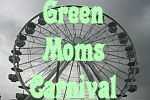How to Pack A Cheap and Easy Waste-Free Lunch
There are many eco-friendly options available for school lunch, but let’s face it: most of them are still pretty pricey. Shelling out $21 for a Sigg water bottle or $37.95 for a Laptop lunch box adds up to big bucks quickly.
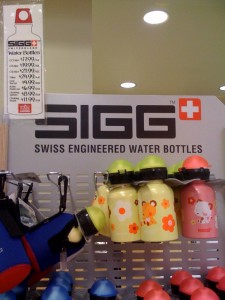
The very popular Sigg bottles range in price from $17.99 to $24.99 at this Bethesda Whole Foods.
Here are five super cheap, easy ways you can send your kids back-to-school with an eco-friendly lunch bag. If you’re fortunate enough to have what you need already, maybe you could take this post and send it to a school list serv or to others who might find this information helpful.
There are really just five things you need for a waste-free lunch:
1. Lunch box – or brown bag. While there are great eco-friendly lunch box options out there, most range from $14 on up. You can buy a pack of 100 brown paper lunch bags for $1.99. No, it’s not totally waste-free, but most municipalities recycle paper – so you can toss the bag out with the newspapers to be recycled! It’s a much more environmentally friendly option than buying a conventional school lunch bag, which are often made of PVC plastic. Read here to learn why you want to avoid PVC, which is harmful to our health and to the environment.
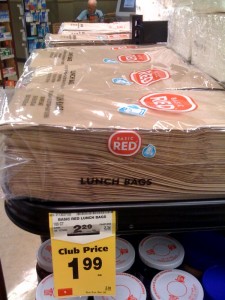
As seen in a Bethesda Safeway, buy 2 packages for $3.98 and you'll have enough recyclable brown bags for the entire school year.
2. Water bottles. This is a biggie. Visit nearly any school cafeteria and you’ll see a staggering amount of waste from disposable juice boxes and milk containers. Yet most stainless or non-PVC water bottles are $10 and up – some as high as $25 or more. Before I invested in two Sigg Mr. Sharky’s (pictured below), I used a good ole Honest Tea bottle. Made of durable glass, it was fine for drinks on the go. I still use one in a pinch!
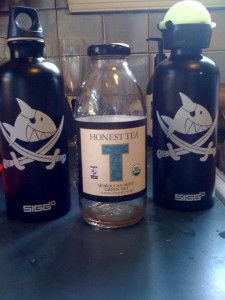
A durable glass bottle, such as this Honest Tea bottle, can be reused as an on-the-go water bottle.
3. Cloth napkin. No need to buy new here. Pretty much everyone has a spare dish rag or dish towel lying around the house, or some “good” cloth napkins that are only taken out for “special occasions.” These are perfect for school lunch. So far, my son hasn’t asked why he carries a linen dishcloth with a 1977 calendar on it, but I’m sure that day is coming soon…!
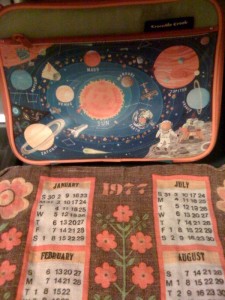
Yes, that's my mother's calendar dish towel from 1977, now doubling as a napkin in my son's lunch box. Do I get a Reduce, Reuse, Recycle, Refuse award for this?
4. Food containers. My how things have changed just in the past year. Now you can buy stainless steel containers for school lunch. But again, cost is an issue. If you don’t want to spend $40 for an all-in-one lunch kit or $16 for a stainless steel food container, you can go the el cheapo route like I did.
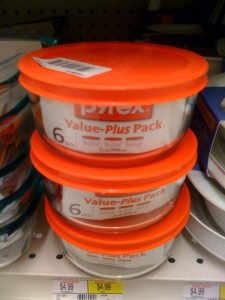
Three of these glass Pyrex food storage units sell for just $4.99 at a Bethesda Giant Food store.
Unfortunately there are no more of these nifty $4.99 glass pyrex containers at the Bethesda Giant, because I bought out their entire stock!
And here’s a shot of Big Boy with his lunch bag, which contains some plastic (gasp) Gerber food containers. I love these. They’re made in the good old USA, they’re cheap (under $5 for 4 small dishes) and they’re made of #5 plastic, which does not contain BPA. Still, to be on the safe side (because all plastics can leach) I keep these plastic bowls out of the dishwasher and the microwave I had to search high and low for these – they seem to sell out as soon as they’re in stock, but you can sometimes find them at Target or Buy Buy Baby.
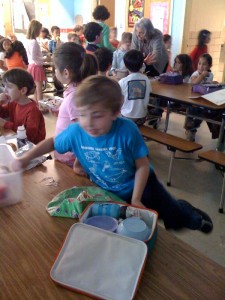
He’s also carrying a more traditional “Green Mom” accoutrement – a Wrap n’ Mat sandwich wrap, which is made of washable cloth and durable, low density polyethylene (LDPE). These sell for $7.99 on the Internet, but I bought mine locally at My Organic Market. When I hit the Wrap n’ Mat website as I was writing this post, I learned that they’ve just introduced little snack pouches, which sell for $8.99 each.
5. Cutlery. This past school year I packed lunches with our regular cutlery, and unfortunately I regret it because some of our silverware never made it home. This year I’m trying Sporks !
And I leave you with a picture of my boys’ trusty Crocodile Creek lunch bags being cleaned out. Because this frugal green Mom isn’t planning to buy new ones this year!
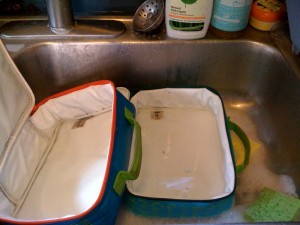
This post is for the Green Moms Carnival: Green Schools Edition, which runs tomorrow (Monday, August 10th) right here at OrganicMania.
— Copyright 2009 OrganicMania
Filed under Bethesda, Food, Giant, Green moms, Green Schools, My Organic Market, Product Recommendations, Savings Tips, School lunches, Sustainable Packaging, Tips, Whole Foods | Wordpress Comments (13) |Thank You, Anonymous Leaker. Now What?
Thank you to whomever had the gumption to send the now infamous Bisphenol A (BPA) meeting notes over to The Washington Post. Notes that exposed discussion about developing a PR plan to restore BPA’s luster and to block proposed bans on the controversial chemical. BPA is used in the linings of canned foods and beverages in the US, yet has been linked in numerous independent studies to myriad health concerns such as endocrine disruption, cancer, diabetes and heart disease (as I’ve previously blogged here.) (You can read the meeting notes from the Cosmos Club discussions with Coca-Cola, Alcoa, Del Monte, Crown, the American Chemistry Council, the North American Metal Packaging Alliance, Inc. and the Grocery Manufacturers Associations here at the Environmental Working Group’s website.)
There’s nothing unusual about industry insiders sitting down to craft an image campaign to bolster a failing product’s allure. These steps outlined in the memo are standard marketing tactics: Fund a consumer perception study. Craft some new messages. Find a marketable spokesperson (in this case a pregnant woman).
But was is unusual is this: for a chemical that is supposed to be so safe, why do the notes show no discussion about the overlooked benefits of BPA? If the problem truly is “perception,” why didn’t the participants spend their time talking about the key points supporting their position that BPA is safe? And why did someone feel compelled to leak the notes if everything truly was on the up-and-up?
According to the notes, the accuracy of which were verifed by a NAMPA spokesperson in The Post article, the attendees spent their time discussing budget ($500,000 for the campaign) and tactics. Funny thing is, they’ve already had a big PR firm, Stanton Communications, representing them. According to O’Dwyers, Stanton also represents The Formaledehyde Council, coincidentally the same group that left snarky comments on Mom blogs after we blogged about the Campaign for Safe Cosmetics’ Toxic Tub report.
Now, in this recession, in this town, $500,000 is a lot of money for PR work. NAMPA and its allies can secure the finest communications council DC has to offer for that princely sum. But according NAMPA’s website, Stanton already reported in February that “In just the first four weeks of 2009, more than 150 articles have been published in various trade, environmental, health, and consumer media. While the specific content of the articles has varied, the underlying message is the same — BPA found in plastic products and metal cans is harmful to people and should be avoided or eliminated. .. . This underscores the need for swift and consistent response to articles as they appear, to set the record straight on BPA, specifically in relation to its critical usage in metal packaged food and beverage products.”
In NAMPA’s response to The Post story, also posted on their website, they state, ”The use of BPA-based epoxy liners in metal food and beverage cans serves a critical function by preventing a myriad of contaminants from penetrating into the food, affording longer shelf life and significant nutrition, convenience, and economy. Unfortunately, the one-sided reporting so commonplace in the media has left consumers to conclude that rather than preventing health impacts, the epoxy liner itself causes problems because it contains infinitesimal amounts of BPA.”
So is this their entire defense? BPA prevents contamination from penetrating into food and it’s approved by the FDA. NAMPA appears to imply that we should ignore advice such as this one issued on May 21st from Harvard’s School of Public Health: “With increasing evidence of the potential harmful effects of BPA in humans, the authors believe further research is needed on the effect of BPA on infants and on reproductive disorders and on breast cancer in adults.”
Hmmm…how do they sell Coke in Japan? The Japanese, who banned BPA, must have found a suitable alternative that does not contaminate the food supply. And while it’s true that BPA is not banned in Europe, it’s also true that countries around the world are reviewing their laws. From NAMPA’s own May e-newsletter I read “NAMPA has learned that the Danish Parliament has proposed a law to ban BPA in baby bottles and other consumer products. The proposal acknowledges the European Food Safety Agency’s (EFSA) approval of the use of BPA in 2008, but dismisses this finding and indicates its
unsuccessful efforts to have EFSA apply more severe rules governing BPA.”
Here’s an offer. When NAMPA gets its act together, I’d love to talk to their new high-priced PR firm to get answers to my questions. I’m sure I could get some other Mom bloggers to join me, those who’ve just posted their own reactions to the specter of a pregnant woman hawking BPA products: The Smart Mama, Green and Clean Mom, Nature Moms, Safe Mama, Non Toxic Kids, The Soft Landing, Jenn Savedge of Mother Nature Network and The Green Parent, Retro Housewife Goes Green , and Leslie aka La Mama Naturale over at Eco Childs Play. How about a blogger conference call?
To round it out, let’s invite Consumer Reports too – as their blog says, “We have repeatedly called for BPA to be banned from food and beverage containers, and for the government to take immediate action to protect infants and children from BPA exposure. Some manufacturers and retailers have already begun removing BPA from their products. We hope that more will follow that example rather than relying on cynical public relations gimmicks.”
What do you think? Leave a comment and share.
Lynn
Copyright OrganicMania 2009
Filed under Cancer, Green Ideas & Stuff, Green moms, Product Recommendations, Sustainable Packaging | Wordpress Comments (15) |Organic & Green Savings: CVS, Whole Foods & Bethesda’s Giant Food
It’s been a while since the last Green and Organic Savings feature. With all this child advocacy, green activism, and taking care of clients, I’ve not had time for long, leisurely shopping trips. Mr. OrganicMania has picked up the slack, but that’s going to change.
Anyway, this week, you didn’t even need to make it to the stores to see some fabulous deals at Whole Foods, Safeway and CVS, thanks in part to some old-fashioned direct mail pieces and newspaper inserts.
CVS has an incredible deal running on Physician’s Formula make-up. With your CVS card, you can buy one, get 50% off one Physicians Formula cosmetic. And check your newspaper coupon insert today. The Sunday Washington Post has a $1 off coupon for Physicians Formula. As I blogged here, not all of their products score the best ratings in the Cosmetics Safety database, but five of their 185 products score “low hazard” ratings, so OrganicMania recommends you try these Physicians Formula products: liquid eyeliner, finishing veil, pressed powder, concealer stick, and extra sensitive skin sunblock. If you have questions, you can check out their ratings at the Environmental Working Group’s Cosmetics Database here.
Next time you’re in Whole Foods, be sure to use the Green & Black’s $1 off coupon from the Whole Foods Whole Deal newsletter (good through July). I’ve raved before about Green & Black’s delicious organic chocolate here at OrganicMania, over at Big Green Purse, and at The Daily Green, but since it’s nearly summer I decided to try their ice cream. Wow. It’s fantastic! Thanks again to my bloggy friend Wrekehavoc for turning me on to Green & Blacks Organic!
If you’re anywhere near Bethesda, be sure to check out the Arlington Road Giant, which is running a triple coupon deal through June 4th. You can find the triple savings coupons in a newsprint mailer sent to area homes. Now of course you don’t want to use those coupons for junk food, so I decided to scour the net to look for organic coupons for under $1 each that could be used at Giant to qualify for triple savings. The Giant deal means you can save up to $2.97 on each of five items, for $14.85 in savings! After looking at national organic brands with distribution at Giant including Stonyfield, Ian’s, Newman’s Own, Green & Black’s, Amy’s Organic, Annie’s Naturals and Earthbound Farm, incredibly I could only find valid online coupons (those under $1) at Stonyfield Farm. (Disclosure: Stonyfield is a sponsor of OrganicMania’s trip to BlogHER, but honestly I couldn’t find valid under $1 coupons anywhere else! Leave a comment some if you happen to find them!)
Stonyfield has 14 different online coupons available including .50 off their new Oikos organic Greek yogurt, as well as organic milk, Yo Baby, Smoothies and more. You need to register here before accessing the e-coupons.
Did you find any other great deals on organic and green products? Leave a comment and share!
Note: I’m looking for two additional sponsors to help defray the cost of my BlogHER trip. If you represent a sustainable brand that you think may be a good fit with OrganicMania, please email me at organicmania at gmail dot com.
Lynn
Copyright 2009 OrganicMania
Filed under Bethesda, Coupons, CVS, Food, Giant, Organic Prices, Product Recommendations, Savings Tips, Where to Buy Organics, Whole Foods | Wordpress Comments (4) |My Kind of CE-Yo
Thanks to Stonyfield Farm, I’ll be heading out to my first BlogHER conference this July in Chicago. I’m not sure which I’m more excited about – finally getting the chance to attend the big BlogHER conference, or the sponsorship from Stonyfield.
Stonyfield’s PR firm offered me the sponsorship, which is actually in return for promoting their new yogurt, Oikos, the only organic Greek yogurt on the market. They sent me some product pix to feature here on OrganicMania.
So who’s that guy? Why is his photo posted instead of the product beauty shot?
That, my friends, is Gary Hirshberg, otherwise known as Stonyfield’s CE-Yo. And although I do enjoy Stonyfield Farms yogurts, I really love what Stonyfield stands for. As I blogged just yesterday, if there’s one thing I’ve learned over the past few years of studying the green and organic market, it’s this: organic does not always mean green and sustainable, and green and sustainable does not always mean organic.
But Stonyfield is an organic company that operates its business sustainably. In fact, Gary Hirshberg was an environmental activist and windmill maker back when he first got involved with biodynamic and organic farming methods. The company started buying carbon offset credits more than 10 years ago, before most people had even heard of global warming. They do great things like donate funds to one of my favorite organizations, The Environmental Working Group, work hard to reduce waste, support and mentor other sustainable businesses, conserve energy, and make sustainable packaging choices.
There’s all kinds of consumers out there. I’m the deep green type. Show me a company that’s making a difference, and I’ll gladly buy their products.
Thanks, Stonyfield!
And now for the next question…how do I get to Chicago? Hmm….anyone have any connections to Amtrak? I have visions of another sponsorship…this one to promote rail travel as having less environmental impact than air travel.
— Lynn
Copyright 2009 OrganicMania
Filed under Blog, Marketing, Organics, Product Recommendations, Sustainable Packaging | Wordpress Comments (5) |The Aftermath of the Green Moms Carnival: Hysterical Mommy Bloggers?
By now, I thought my mind would be on blogging about Tips for an Eco-Friendly Easter. But instead, I keep thinking about how the personal care products industry responded to the concerns raised by last week’s Green Moms Carnival. The Green Moms asked questions about the safety of the tens of thousands of untested, unregulated chemicals used in personal care products such as shampoos and household cleaners, and the presence of small amounts of probable carcinogens such as 1,4 dioxane and formaldehyde in products such as baby wash.
The industry’s response was to:
1) ignore our questions – even when we telephoned;
2) send out form emails like this one that didn’t address our questions; and
3) engage this “crisis management” PR firm to leave comments on our blogs alleging that both the Green Mom bloggers and the Campaign for Safe Cosmetics and the Environmental Working Group, the environmental groups behind the studies, were “irresponsible,” were causing “hysteria,” and suggesting that we needed to do more “critical thinking.”
Check out my friend Jennifer Taggert’s post, “Oh, don’t worry, you’re just a mommy blogger & just a little bit of a carcinogen is okay.” Read the comments.
Prior to the carnival, I was a bit skeptical of the need for the Kid Safe Chemicals Act. Because Ad Age recently reported on J&J‘s new social media campaign and their desire to “deepen engagement” with Mom bloggers, I expected they would welcome a call from a blogger asking for J&J’s perspective prior to publishing a blog post. Regrettably, that was not my experience with J&J, nor with the Personal Care Products Council.
I hoped that my efforts to reach out to industry before publishing my post for the Green Moms Carnival would lead to more confidence in the state of the industry and the existing regulatory system, not less confidence.
As Mary Hunt says here, “I find it amusing that if women are surveyed by a paid for research firm, their answers are sanctified and considered valid feedback. But if women give the same opinions freely on the web without “being asked,” then they are hysterical or overreacting. The only difference is that someone in the middle was paid to ask the question. Go figure.”
Happy Easter, Happy Passover, everyone. I’m going to try to go off and focus on dying eggs the natural way. I’ll try not to eat too much Fair Trade Easter chocolate. But this isn’t over. If anything, the industry’s response to our concerns has galvanized us to action.
Lynn
Copyright 2009 OrganicMania
Filed under Baby, Cancer, Green Cleaning Products, Green moms, Organic Personal Care Products, Product Recommendations | Wordpress Comments (21) |It May Be April Fool’s Day, But Toxins in Baby Bath are No Joke
It sounds incredible: probable human carcinogens like formaldehyde in children’s bubble bath. Yes, today is April Fool’s Day, but this is no joke. This is the sad reality of the state of our personal care products industry.
How did we get to this point? It’s a function of our regulatory system (or lack thereof as some might say). According to the non-profit Environmental Working Group, “The nation’s toxic chemical regulatory law, the Toxic Substances Control Act, is in drastic need of reform. Passed in 1976 and never amended since, TSCA is widely regarded as the weakest of all major environmental laws on the books today. When passed, the Act declared safe some 62,000 chemicals already on the market, even though there were little or no data to support this policy. Since that time another 20,000 chemicals have been put into commerce in the United States, also with little or no data to support their safety.”
And if this is news to you, you may be asking why you’re learning about this only now. The Campaign for Safe Cosmetics just last month released its “No More Toxic Tub” report, which included lab results showing that personal care products are commonly contaminated with formaldehyde or 1,4-dioxane – and, in many cases, both. According to the report, “These two chemicals, linked to cancer and skin allergies, are anything but safe and gentle and are completely unregulated in children’s bath products.”
But you know what? This isn’t new news. It may be new to you because perhaps you’re a new parent who is just for the first time paying careful attention to what goes into the bath water with your baby. But the fact is, you can find reports like this one about 1,4 dioxane and formaldehyde dating back to 2007 – and I imagine, even earlier. (Updated 4/3: Here’s a link reporting that in 1982, “the industry-funded Cosmetic Ingredient Review panel noted that the cosmetic industry was aware of the problem of 1,4-dioxane in cosmetics and was making an effort to reduce or remove the impurity.” )
The makers of these products claim they are completely safe and meet all government requirements. J&J’s products are bearing the bulk of the criticism from today’s Green Moms Carnival because of J&J’s ill-timed “Big Bubblin Stars” video campaign. But the fact is, J&J does meet all US requirements. Levels of formaldehyde in the J&J products are even below EU levels, which is significant because many American consumers try to follow EU standards for personal care products because they believe them to be safer than the US standards.
But the issue is not J&J’s products alone. Why? We are exposed to thousands of personal care products over our lifetimes. If each one of these products leaches trace amounts of potentially toxic chemicals into our bodies – as tests like the EWG’s “Body Burden” test have shown – then the effect is a cumulative one. And when you’re talking about infants, small children, and young people in their reproductive years, the potential effects are really unknown. We do know that chemicals have been linked to cancers. We do know that we’ve seen a marked decrease in fertility in this country and an increasing number of reproductive diseases. Are they connected to repeated chemical exposures from birth on? I agree with Dr. Philip P. Landrigan, Professor and Chair of the Children’s Environmental Health Center at New York’s Mount Sinai School of Medicine. He says, “Children are not simply ‘little adults’. They are uniquely vulnerable to toxic exposures in the environment. Exposures in early life can affect human health over the entire life span. We need to find definitive answers about the relationship between toxic chemicals and health so we can protect our children now and in the future.”
In response to past criticism, J&J’s spokesperson Iris Grossman has said, “It’s important to stress that all our products are within the FDA limits.” But that’s just the problem. Are the FDA limits appropriate? Unfortunately, one of the legacies left us by the Bush Administration is the public’s fundamental distrust of our regulatory system. The public has just been burned too many times by lax oversight. Look at our financial markets. The SEC claims it wasn’t aware of the extensive use of derivatives in our secondary markets. Heck, I remember learning about derivatives way back in ’97 when I was at Georgetown’s Business School. No, I didn’t understand them, but I still remember scribbling this note: Derivatives: Stay Away!!! Then there’s the sad state of our food safety oversight. How many more people will have to die of salmonella before we get that under control? What about the lead in children’s toys? I shouldn’t have to cart my toys over to The Smart Mama for a thorough lead inspection.
Many will advocate for more regulation, such as the Kid Safe Chemical Act supported by the Environmental Working Group. But regulations don’t always work as intended. The CSPIA, enacted to prevent the sale of items containing lead, has inadvertently caused many small makers of children’s products to go out of business because they couldn’t afford to comply with the testing requirements imposed by the new law. Then there’s the response to the banking crisis. While the government was celebrating the passage of TARP, the bankers were celebrating the fact that the law didn’t require them to start lending again. How do I know that? I first learned about it at a Washington Christmas party, well before that scandal had finally hit the press. And now that spring is here? The credit markets still remain frozen.
So is The Kid Safe Chemical Act the answer? Will it cause more problems than it purports to solve? Will it inadvertently cause harm to the natural and organic purveyors, by causing them to comply with burdensome regulation, just like what happened when the USDA Organic regulation and the CSPIA was passed? I don’t know. I don’t claim to be a regulatory expert. But I do know something about marketing. And I know that the profit margins on personal care products – beauty products in particular – are incredibly high. It is a very lucrative business, and in most cases the biggest expense is not producing the product, it’s marketing. It’s paying for all the free samples and glossy magazine ads that personal care products companies routinely hand out.
Of course, it’s a different matter in the natural and organics market. There, the cost of all natural alternatives to synthetic chemical ingredients is high. And consequently, on a percentage basis, they spend less on marketing than companies like P&G or J&J.
As an MBA and a New Jersey native, I have very dear friends who have worked at leading personal care companies like J&J, Bristol Myers Squibb, and P&G. Of course they believe their products are safe and comply with US law. But that’s not the whole issue. Someone – either the personal care industry as a whole – or the US government – needs to take a closer look at the 82,000 chemicals used in our personal care products to assess the likelihood that they are contributing to our sky high cancer rates and the increasing incidence of reproductive abnormalities.
And as a former newspaper reporter, I know that there are two sides to every story. So I called J&J before publishing this blog post. I wanted to understand their stance on the Kid Safe Chemical Act and the possible adverse affects of long term exposure to the multitude of chemicals in our personal care products. Their spokesperson, Iris Grossman, could not respond to these questions, although she did offer to put me in touch with their “Mommy blogger” person. I pointed out to her that if she couldn’t answer my question, I didn’t think a “Mommy blogger” specialist could either. Then the shock set in. As a marketing and communications professional, I know that every company has a set of standard Q&As used to respond to the media. I asked her if this meant that NO ONE had ever asked these questions before:
– What is J&J’s stance on the Kid Safe Chemical Act?
– What does J&J think about the adverse affects of long term exposure to the thousands of chemicals used in personal care products?
– Is this issue even being discussed at the industry level, through groups like the Personal Products Council?
So what can you do? Here are a few choices:
1. Sign this petition in support of the Kid Safe Chemical Act.
2. Fill out this web form to contact J&J and tell them you want them to lead an industry-wide effort to overhaul the Toxic Substances Control Act. Or, leave a comment on the J&J blog.
3. Contact the Personal Care Products Council here and tell them you expect a better response to the EWG report than the one that their Chief Scientist gave US News & World Report. “These are issues that have been around for many, many years, so it’s not new news. The thing that impressed me was the low levels of dioxane that were found in these products, which indicates to me that the industry is doing its job in keeping this potential contaminant down to a low level.” (And yes, I’ve called the Personal Care Products Council and am just waiting for a call back).
4. Check the EWG’s Skin Deep data base to find safer alternatives to the products identified in the Campaign’s report.
5. Use fewer personal care products and try to find those with fewer, simpler ingredients.
6. Contact your Congressional representatives to let them know you support Kid Safe. Support is especially critical in Pennyslvania and California. This press release from Senator Lautenberg’s office includes good background information on the bill. If you or someone you know lives in PA, check out this link.
If you live in CA, check out this link.
What do you think? Please leave a comment and share. And if you want to talk about the issue, I’ll be on the radio today along with Jennifer Taggert, The Smart Mama, and Lisa Frack of the Environmental Working Group. You can listen to us here and call in with questions at (530) 265-9555.
Thanks for reading this far! This was a longer than usual post, but I felt I needed the space to make these arguments.
— Lynn
Copyright OrganicMania 2009
Filed under Green Cleaning Products, Green Ideas & Stuff, Green moms, Marketing, Organic Personal Care Products, Organic Product Needs, Product Recommendations | Wordpress Comments (17) |Great Deals on Recycled Toilet Paper & Why TP Shouldn’t Be at the Bottom of Your Green List
Perhaps you saw the news a few days ago: reports from Greenpeace, publicized in The New York Times, Fast Company, and the UK newspaper The Guardian, which emphasized the importance of choosing recycled toilet paper over “squeezably soft” brands, which get that softness from wood pulp found only in virgin forests.
Going green involves huge changes in buying behaviors: everything from food to clothing to houses, cars, and even toilet paper gets looked at with increased awareness of its ecological impact.
And for many of us — well, swapping out our favorite toilet paper brand is at the bottom of the list. I’ll admit it: I didn’t give much thought to recycled toilet paper, figuring that I’d just wait until the prices came down and the quality came up. Memories of scratchy paper from overseas didn’t do anything to encourage me to check out recycled toilet paper, and frankly, I didn’t realize the extent to which premium toilet paper is taken from old growth forests. (Read more of this disturbing news here).
So I took a fresh look at recycled toilet paper versus conventional, and found big changes in the marketplace. Did you realize you can buy recycled paper for less money than conventional toilet paper?
CVS recently introduced CVS Earth Essentials, recycled content napkins, toilet paper, and paper towels. I decided that at .89 cents a roll, I could spring for one, and put it to the test versus Scott bathroom tissues, available on the same drugstore shelf for $1.29 per roll, and Seventh Generation, available at Whole Foods for $1.39 per roll.
The verdict? Recycled toilet paper has come a long way. Yes, from the perspective of “The Princess and the Pea,” you do notice a bit of a difference, but it is very slight and not nearly enough to merit being called “scratchy.” The quality is equivalent to the type of toilet paper you find in most public buildings. It’s fine.
And it’s really cheap in bulk. After the successful home test, I returned to CVS to stock up. They’re running a sale on four packs of Earth Essentials, now $3.49, on sale from $4.69 through April 30th. That’s a $1.20 savings per 4-pack. But the savings really add up when you buy a 12-pack for $8.99. That’s less than 75 cents per roll. And if you have a CVS “ExtraCare card,” you may reap even more savings. My initial .89 cent purchase yielded a $5 off any $15 purchase, so when I returned to pick up the 12-pack, I added a few other things in my cart and saved even more.
The CVS Earth Essentials toilet paper rated a “Green Tree” stamp of approval from Greenpeace. (Unfortunately the other Earth Essentials products didn’t rank quite as highly as their toilet paper). Check out the Greenpeace guide here. Other good bets for best buys include the Trader Joe’s house brand and Whole Foods 365 brand. And don’t forget, you can often get 10% off a case of goods such as toilet paper at your local market – just ask! My Organic Market offers this discount plus a “best price” guarantee. Other good sources include CSAs, which often stock paper goods too.
So what are you waiting for? Take the switch to recycled toilet paper off the bottom of your list today!
— Lynn
Copyright OrganicMania 2009
Filed under CSAs, CVS, Giant, My Organic Market, Organic Personal Care Products, Organic Prices, Product Recommendations, Savings Tips, Tips, Trader Joes, Where to Buy Organics, Whole Foods | Wordpress Comments (15) |Organic and Green Savings: A Great Time to Try Organic Kids Food
Just wanted to pass along the news that my client Mom Made Foods is offering a great deal to celebrate the new year. Now when you buy any 4 Mom Made Meals or Munchies at SuperTarget by January 19th, you can redeem your UPC codes for a $9 SuperTarget gift card plus special savings codes from GDiapers and Bebe au Lait! Grab your rebate form and all the details here.
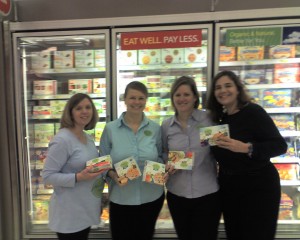
The MomMade Team! (L to R, Laura Waldron, Marketing Manager; Jennifer Mulchandani, Marketing Director; Heather Stouffer, Mom Made Founder; and Lynn Miller, Miller Strategic Marketing and OrganicMania).
This $9 rebate offer is a great excuse not only to try Mom Made organic frozen foods, but to visit a SuperTarget! I tweeted a while back about the surprises I found on my “roadtrip” to a SuperTarget with the Mom Made team. I had no idea that SuperTargets had such an expansive organics section – including fresh organic produce, all at great prices, of course!
For more than a year now, I’ve been blogging about the need for more healthy, organic and natural products at prices that make sense. During this time, we’ve discussed money savings tips such as the expansion of Giant’s organic lines, great savings on Archer Farms house brand organics at Target, coupons from Whole Foods, and more. And now we see SuperTarget, recently named one of the top 10 healthiest grocery stores by Health Magazine, as another high quality option for organic foods at a good price.
Take a look – and let me know what you think!
And as for the Mom Made? Well, there are four options to choose from, but I’d be holding out if I didn’t tell you that Baby Boo and Big Boy prefer the Cheesy Mac (with peas!) and the Cheese Pizza. As for me? After a long day, I’ve been known to kick back with a Mom Made Bean Burrito and a beer!
Looking for more savings tips? Check these out over at Thrifty Thursday on greenbabyguide.com and these at Frugal Friday!
Bon Appetit!
— Lynn
Copyright 2009 OrganicMania
Filed under Consulting Business, Coupons, Food, Organic Prices, Product Recommendations, Savings Tips, Where to Buy Organics | Wordpress Comments (5) |My New Years Gift to You: Tip on the Best Value Sparkling Wine
Well, I tried to take a blogging break over the holidays, but I can’t stand looking at that old Christmas gift post, so here I am sneaking in a post mid-afternoon on New Years Eve.
Most of us are looking to live a bit more frugally this year. (Of course, we’ve been sharing frugal and green savings tips on OrganicMania for more than a year now!)
So this year, instead of tipping back the Veuve Cliquot, I’ll be trying Graham Beck Brut, a fantastic bottle of sparking wine you can pick up at Whole Foods for $15, or perhaps find even cheaper at a local market. (Check here). As one expert put it, “It will be very difficult to find a sparkling wine this good at this price.”
All I know is, if you love Veuve, you’ll love this…and it’s a lot easier on the wallet!
Wishing you all the best for a Happy New Year!
Lynn
Copyright 2008 OrganicMania
Filed under Holidays, Product Recommendations, Savings Tips, Whole Foods | Wordpress Comment (1) |10 Tips for Avoiding Recalled Toys
Do you see what’s on that paper lying next to those cute toy trains? A recall notice for those very same trains.
Those My Little Train Toy Classics were so darn cute that I picked one up to admire it. And it was cheap too – less than $2.
But those cheap toys always give me pause. So many of them have been linked to recalls and lead paint. So I decided against purchasing one, even though I’m not prepared to spend loads of money on an all natural, organic alternative.
As I was leaving the store, I noticed a recall notice on the bulletin board near the exit. I picked up the recall notice and ran back to see if these were the same trains. After taking them all down from the display, I brought them over to the customer service desk, showed them the recall notice, and explained that they were selling recalled toys. I expected an apology, or at least an expression of concern from the store personnel…but their response didn’t satisfy me. My immediate reaction was to send out this irate Tweet to my Twitter network.
The next day I called the store manager, and asked him if he was aware of what had happened with the recalled toys the evening prior. He wasn’t. No one had yet bothered to tell him that they had recalled toys on their shelves. He assured me that there was no way I could have purchased a recalled item, because the item would not ring up at the register. He also told me that it was likely that just a lot of the item that was recalled, and that the items on the store shelf were probably fine. Well, no. I checked the Consumer Product Safety Commission website and in fact, all of these toy trains have been recalled due to a choking hazard.
It’s tempting to buy cheap toys – but it’s not worth the risk. They’re often full of toxins (just ask my friend with a toy testing gun, The Smart Mama). And even if they’re safe, they usually don’t last very long before they break.
Few of us can afford to buy all natural, organic toys all the time. So what can you do? Here are ten tips:
1. Before you buy anything, go to the Consumer Product Safety Commission and check the recall list. The notice on the toy trains came out the very day I saw them on the store shelf! (And five more alerts have come out since that one was issued!)
2. Shop consignment stores. You won’t believe the number of high quality wooden toys you can find, some still new and in the original packaging. In the DC area, I like to shop at The Purple Goose and Wiggle Room.
3. Ask your friends for their cast-offs. I have one dear friend in Florida who mails her son’s hand-me-down clothes to us. There’s no reason you can’t get cast-off toys too. (I’d like to get in line for cast-offs from the son of natural toy expert MC Milker of Not Quite Crunchy Parent!)
4. Check yard sales, especially in what my mother used to call “the high rent district.” That’s where you may find gently used, natural and organic toys.
5. Zwaggle is a great source for parents to swap gently used toys.
6. Freecycle is full of environmentally conscious people who love to recycle. These are the same people who are likely to have purchased high quality toys. Post a query requesting your child’s dream toy. Who knows? Maybe you’ll get it for free!
7. Look for discount coupons on line. Simply google the name of the toy and “coupon,” and see what turns up. And here’s an easier way you can save some money on high quality, natural toys. To save 10% off your first order at Natural Pod, just use coupon code GCM08.
But these are only temporary steps. The only way we will keep junk toys out of the store aisles is by exerting pressure on government to strengthen the regulations governing toy safety and inspections. Here’s what you can do:
8. Call or write your Congressional delegation and tell them that you want more resources devoted to the Consumer Product Safety Commission, the agency tasked with ensuring the safety of our children’s toys.
9. Write to your state and local representatives too. States like Washington and Oregon are ahead of federal law it comes to protecting our kids from unsafe toys.
10. Align yourself with organizations that are lobbying the government on behalf of children’s issues. Groups such as Momsrising lobby for passage of laws that help protect kids not only from recalled toys, but from toys containing unsafe levels of chemical toxins.
How are you going to handle toy shopping this holiday season? Leave a comment and share!
— Lynn
Copyright OrganicMania 2008
Filed under Eco-friendly toys, Green moms, Holidays, Marketing, Parenting, Product Recommendations, Tips | Wordpress Comments (10) |
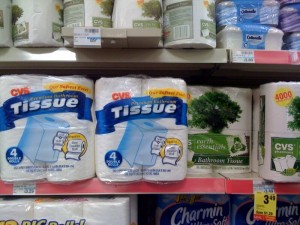
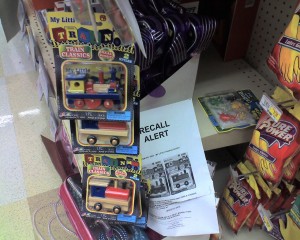
 My StumbleUpon Page
My StumbleUpon Page


